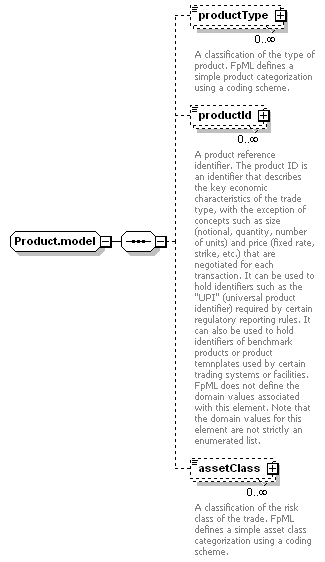
Namespace: |
|
Content: |
3 elements |
Defined: |
globally in fpml-shared-5-3.xsd; see XML source |
Includes: |
definitions of 3 elements |
Used: |
at 2 locations |

Complex Content Model |
| productType*, productId*, assetClass* |
| assetClass (defined in Product.model group), | productType (defined in Product.model group) |
| <xsd:group name="Product.model"> <xsd:sequence> <!-- added BAL 2011-02-20 to address CFTC reporting requirements --> <!-- <xsd:element name="productSubType" type="ProductSubType" minOccurs="0" maxOccurs="unbounded"> <xsd:annotation> <xsd:documentation xml:lang="en">A finer grained classification of the type of product. FpML defines a simple product subtype categorization using a coding scheme.</xsd:documentation> <xsd:appinfo> <view:override view="transparency" minOccurs="1"/> <view:override view="recordkeeping" minOccurs="1"/> </xsd:appinfo> </xsd:annotation> </xsd:element> --> <!-- end BAL 2011-02-20 --> <!-- added BAL 2011-02-20 to address CFTC reporting requirements --> <!-- <xsd:element name="subAssetClass" type="SubAssetClass" minOccurs="0" maxOccurs="unbounded"> <xsd:annotation> <xsd:documentation xml:lang="en">A narrower classification of the risk class of the trade than asset class. Used to represent things like type of commodities (e.g. energies, base metals, etc.) . FpML defines a simple asset class categorization using a coding scheme.</xsd:documentation> <xsd:appinfo> <view:skip view="confirmation" /> </xsd:appinfo> </xsd:annotation> </xsd:element> --> </xsd:sequence> </xsd:group> |
Type: |
AssetClass, simple content |
| xsd:normalizedString |
maxLength: |
255 |
| <xsd:element maxOccurs="unbounded" minOccurs="0" name="assetClass" type="AssetClass"/> |
Type: |
ProductId, simple content |
| xsd:normalizedString |
maxLength: |
255 |
Type: |
ProductType, simple content |
| xsd:normalizedString |
maxLength: |
255 |
| <xsd:element maxOccurs="unbounded" minOccurs="0" name="productType" type="ProductType"/> |
| XML schema documentation generated with DocFlex/XML 1.8.6b2 using DocFlex/XML XSDDoc 2.5.1 template set. All content model diagrams generated by Altova XMLSpy via DocFlex/XML XMLSpy Integration. |